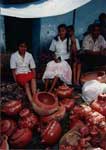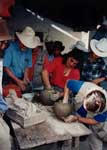|
The next morning, Max hands each of us a clay whistle in the shape of a bird, a chicken, or a lamb.
"This," he announces, pushing back ebony hair with his baseball cap, "marks the beginning of our search for the Lenca-Maya Indian trail."
He continues, sharing his dream of developing an eco-tourism program with the Lenca Indians who, we learn, predate the Maya.
|
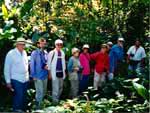 |
|
|
Harvy, Carl, Mark, Gloria, Pattie, Susie, Sharon, John & Max
|
|
|
|
|
|
|
|
Our search for the remains of this ancient history actually began on a jungle hike several days earlier near Lake Yojai at Los Naranjo, the Orange Grove, the site of one of the oldest Olmec ruins ever discovered, dating back to 1600 BC. As we stood on a mound covered with thick vines and tall grasses, we saw two more high mounded forms in the near distance.
|
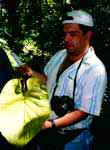 |
|
|
|
Max in the jungle
|
|
|
|
|
|
|
We were standing on a part of the acropolis, Max explained. The additional mounds were also part of the ruins scheduled for an archeological excavation starting next year.
Over the next five days, our search will take us on a climb through the virgin cloud forest of the Guisayote National Park near the border with El Salvador, to Gracias and La Campa, (where we hope to see a religious ceremony of the Lenca Indians); through Max's hometown, Santa Rosa, and end with a couple days at the Maya ruins in Copan. All before we cross into Guatemala, the second part of our trip.
As we leave Santa Barbara, the professor returns once more to say good-bye. He promises to study his English and we, to write him. We send our first post card from Copan; then photographs, months later, of him and La Señora.
Our destination that day is Gracias, the old capital of Honduras whose name, meaning "Thanks," Carl tells us, supposedly derived from the gasp of relief given by Pedro de Alvarado when the exhausted Spaniard stumbled across this rare piece of flat ground in 1527.
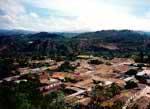 |
|
|
Gracias
|
|
|
|
|
|
|
As history predicted, the road through the mountains to Gracias is a grueling eight hour trip even in a four-wheel drive. The heat is uncomfortable. The van sputters to a halt twice. And Gracias is only our jump-off point to the more distant Indian village of La Campa, where few foreigners have traveled.
Tomorrow, we plan to attend one of the Lenca's most important religious celebrations in La Campa, St. Matias Day. If we are lucky we may also catch the traditional "guancaso," a friendship ceremony between villages, ending months of celebration.
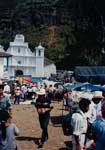 |
|
|
Church
La Campa
|
|
|
|
|
|
|
That evening, we finally arrive in Gracias, a quaint picturesque town, complete with donkeys and their riders moseying up and down the streets. But we barely have the energy to shower and eat let alone explore, and even turn down a trip to the nearby hot springs, which, to our delight, we do visit the following evening.
Early the next morning, after a full breakfast of eggs, tortillas, bananas, rice and beans at a local cafe, we leave for La Campa. Bouncing over rocky roads and forging streams that have at points reclaimed it, our van drives alongside many buses and pickup trucks crowded with pilgrims heading in the same direction. For months, the Lencas from various villages have been making their way to this site.
When we arrive and walk toward the festive market in the shadow of the church, several small groups of people come right up and gaze or smile at us; we, a good head or two taller. We wend our way past aisles and aisles of vendors first in booths, then to those further up the hill, sitting on blankets, surrounded by family, and making tortillas over a wood fire.
All mainly sell pottery, jewelry, food or household items. For a few cents, there are canaries who peck out a piece of paper with your fortune on it. Large bouquets of flowers look fresh out of a Rivera painting.
|
 |
|
|
|
La Campa Market
|
|
|
|
|
|
With the loud sound of a drum, crowds begin to gather at the edge of the marketplace along the main dirt road. We follow Max in time to catch a procession of men carrying a statue of the Madonna amidst colorful flags, masks, whistles and song. Under a dramatic sky, the men continue up the hill past the old church where they are joined by a group of women. Children and visitors run alongside as the procession finally gathers on the hilltop ceremonial site.
|
|

 Part 3
Part 3



